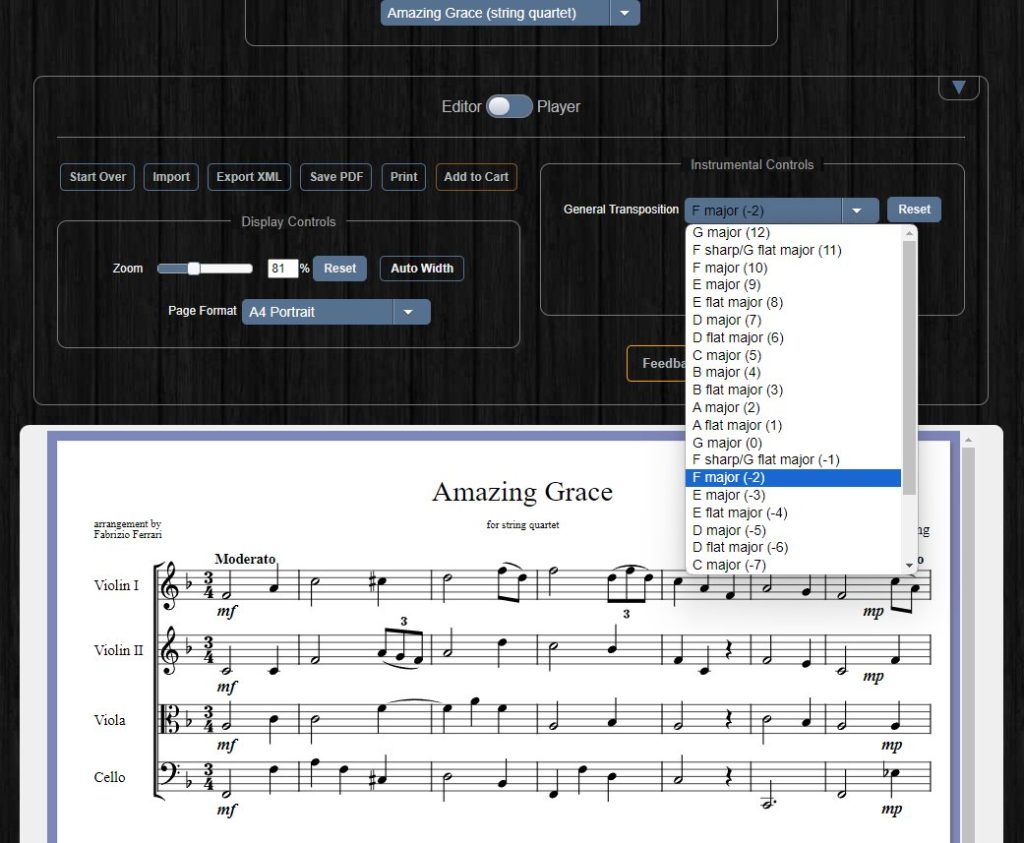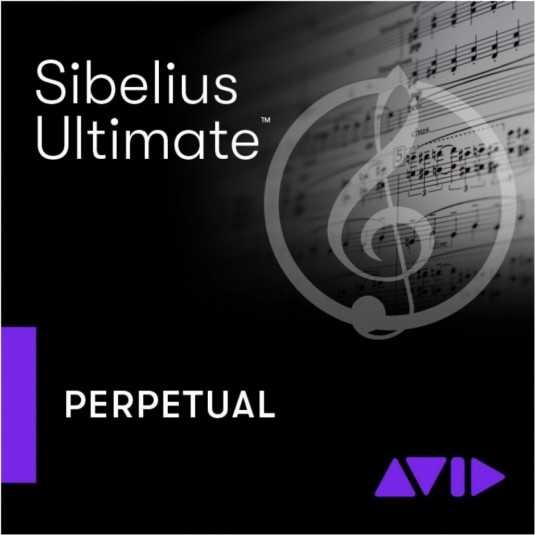Virtual Sheet Music Playground: The Musician’s Online Tool for Easy Sheet Music Editing and Transposing
A post by musica.at

In an age where the digital world is transforming every facet of our daily lives, music composition and education are no strangers to this revolution. The capability to edit and transpose sheet music online has become an essential resource for musicians, composers, and music educators worldwide. By harnessing cutting-edge technologies, the Virtual Sheet Music Playground stands out as a pioneering platform that goes beyond traditional limits, allowing users to engage with music in ways that were once thought impossible. This innovative online music editor not only makes the process of creating and altering musical scores more straightforward but also promotes a more inclusive and interactive approach to learning and performing music.
This article examines the numerous features of the Virtual Sheet Music Playground, detailing how it streamlines the process of editing and transposing sheet music online with unparalleled ease and effectiveness. From understanding the basics of navigating the platform’s intuitive interface to utilizing advanced features such as interactive sheet music, readers will get a thorough understanding of how to maximize the benefits of this online tool. Furthermore, the advantages for musicians at any skill level are explored, showcasing how this platform serves as a valuable asset for all.
Features of Virtual Sheet Music Playground
AI-powered PDF and Image Import
The Virtual Sheet Music Playground introduces an innovative AI-powered PDF and Image Import feature, enhancing the musician’s ability to interact with sheet music. This system utilizes Optical Music Recognition to extract musical information such as notes, pitches, and rhythms from scanned images or PDFs, making them fully interactive. Musicians can now play back, edit, and synchronize sheet music with audio/video seamlessly. Despite being in beta, this feature is robust enough for practical use and continues to improve, allowing for real-time feedback and adjustments.
MusicXML Editor and Viewer
At the core of the Virtual Sheet Music Playground is the advanced MusicXML Editor and Viewer. This tool supports a wide range of MusicXML file operations, from importing and exporting to comprehensive editing capabilities. It is compatible with various music notation software, ensuring a seamless workflow for musicians. The editor allows for intricate modifications of musical scores, including changes to text, dynamics, and even the instrumentation of pieces. This flexibility makes it an essential tool for composers and arrangers working across different musical genres.
Advanced Transposer and Player
The platform’s Advanced Transposer and Player feature is designed to meet the diverse needs of musicians. Whether it’s transposing music by key, interval, or semitone, the tool adjusts all notes, chords, and harmonies accurately, maintaining the musical piece’s integrity. For performers, this means the ability to adapt music to their vocal range or instrument with precision. Additionally, the player component allows musicians to change tempo and use a metronome during practice, providing a dynamic and responsive practice environment.
How to Use the Virtual Sheet Music Playground
Importing and Editing Scores

To start utilizing the Virtual Sheet Music Playground for editing and transposing sheet music, users first need to import their music files. This can be done by clicking the “Open in Playground” button for VSM titles or the interactive sheet music button found on any item’s page. For those looking to work with Hal Leonard items, interactive sheet music is displayed directly, provided it’s available for the specific title. Once imported, users can modify text, dynamics, and even the instrumentation of the scores with ease, making the editing process both quick and efficient.
Transposing and Paginating Music
Transposing music to suit specific needs is straightforward with the Virtual Sheet Music Playground. Users can transpose music by key, interval, or semitone, ensuring that all notes, chords, and harmonies are accurately adjusted. This feature is particularly useful for adapting music to different vocal ranges or instruments. Additionally, the platform allows for flexible pagination changes, enabling musicians to organize their scores precisely as needed. These functionalities underscore the platform’s commitment to providing a comprehensive and user-friendly music editing tool.
Playing and Muting Instruments
The Virtual Sheet Music Playground also offers advanced playback features. Musicians can change the playback tempo and use a metronome to aid in practice. For those working with ensemble pieces, the platform allows users to play only specific instruments by muting others, facilitating focused practice or analysis of particular parts. This interactive approach to sheet music not only enhances practice sessions but also provides musicians with the tools to explore and understand their music deeply.
By following these steps and utilizing the features offered by the Virtual Sheet Music Playground, musicians can significantly enhance their music practice, performance, and overall understanding of their pieces.
Benefits for Musicians
Enhanced Flexibility and Control
Musicians utilizing the Virtual Sheet Music Playground experience unprecedented flexibility and control over their music. The platform allows for easy modifications of music in any key, adjustments to pagination, and changes in instrumentation. This adaptability is crucial for musicians who need to tailor their music for different performances or teaching scenarios, providing a personalized approach to music preparation.
Streamlined Music Preparation
Preparing music for various formats can be complex, but the Virtual Sheet Music Playground simplifies this process. Whether targeting CD, vinyl, streaming platforms, or all three, the platform equips musicians with the tools to efficiently prepare their music. Features like importing MusicXML files, modifying text and dynamics, and exporting music in desired formats streamline the music preparation process, ensuring that musicians can focus more on creativity and performance.
High-Quality Output
The quality of music output is paramount, especially when adapting to different streaming platforms with varying bitrate requirements. The Virtual Sheet Music Playground ensures high-quality audio output, allowing musicians to maintain the integrity and quality of their music across different formats. This is particularly important in an era where music consumption can vary significantly across devices and platforms, from high-fidelity systems to mobile streaming with lower bitrates.
Upcoming Features and Enhancements
Planned New Features
The Virtual Sheet Music Playground is committed to enhancing the user experience by introducing a variety of new features in the near future. These enhancements aim to provide musicians with even more control and flexibility over their sheet music. Soon, users will be able to edit slurs, hairpins, and more objects directly on the score, allowing for a deeper level of customization and expression in their music compositions. Additionally, an adaptive, intelligent transposer is in development. This innovative feature will ensure that parts are correctly adapted to the selected transposition, making the process of transposing music more accurate and intuitive for users. Improved notation capabilities are also on the horizon, promising to make the notation process smoother and more efficient. The team behind the Virtual Sheet Music Playground is also open to suggestions from users, inviting them to share their ideas, questions, or suggestions to further improve the platform.
User Feedback and Requests
User feedback plays a crucial role in the development and enhancement of the Virtual Sheet Music Playground. By collecting meaningful user research, the team is able to prioritize features and improvements based on customer needs and pain points Continuous user feedback loops are established to ensure that the platform remains useful and valuable to customers, thereby reducing risk and cost throughout the development cycle. The process of exploring new ideas begins with open and exploratory interviews to understand user needs that the platform can address. This feedback is then analyzed to inform the product backlog and guide the development of prototypes for usability testing. Through remote testing tools and other methods of collecting feedback, such as live chat, short surveys, and social media, the team gathers insights from users to inform future cycles of development. This ongoing dialogue with users not only helps in building a valuable knowledge base but also ensures that the platform evolves in a direction that meets the needs and expectations of its user base.
Conclusion
Through the exploration of its innovative features and user-friendly approach, the Virtual Sheet Music Playground has demonstrated its pivotal role in revolutionizing music composition and education. This platform not only streamlines the editing and transposing of sheet music but also enhances the musicians’ practice and performance through its adaptive learning tools. Its capabilities to import, edit, and transpose scores with ease, alongside robust playback features, offer musicians of all levels a comprehensive tool to refine their artistry and expand their musical repertoire.
The future enhancements of the Virtual Sheet Music Playground promise to bring even more flexibility and control, ensuring that it remains at the forefront of digital music education and composition tools. As the platform continues to evolve, incorporating user feedback and advanced technologies, it stands as a testament to the transformative power of digital innovation in music. For those eager to explore these capabilities and join a community of forward-thinking musicians, Visit VSM Playground! Together, we are shaping the future of music through collaboration, creativity, and cutting-edge technology.
FAQs
1. Can you also import your own sheet music?
Yes, your own sheet music can be read from PDF files or scanned (photographed) sheet music.
2. Can you play the scores?
Yes, the scores can of course be played – you can set the desired tempo.
3. Can you transpose the music, the scores?
Yes, all voices, all parts can be transposed as desired.
4. Can you also transpose individual parts of the notes?
Yes. Each individual voice can also be transposed separately. This makes it possible to arrange a piece of music for a different cast.
5. Can you edit and print out the sheet music that Virtual Sheet Music offers?
Yes, not all of them, but a lot of the sheet music that Virtual Sheet Music offers can be opened in the Playground with just one click and edited immediately.
6. Can individual voices / parts also be displayed, edited and printed?
Yes, you can select any voices, change the instruments, transpose individual voices and thus rearrange the piece of music for your ensemble.
7. Can I just play individual voices for practice?
Yes, you can also play just a single voice – or you can mute a voice, whose part you take over and all other voices accompany you… In the same way, you can also adjust the volume of the individual voices as you wish.
8. Can I change the playback speed as desired?
Yes, you can set the tempo as desired and also have a metronome play along.
9. Is using Virtual Sheet Music a safe option?
Absolutely, Virtual Sheet Music is a secure platform for accessing sheet music. All digital editions provided by Virtual Sheet Music are 100% legal and are not only photocopies of other music editions, ensuring both safety and quality.
10. Are there also sheet music by Jean Sibelius on Virtual Sheet Music?
Yes, absolutely! VSM has more than 400.000 available scores and also sheet music by Jean Sibelius – take a look here…
Virtual Sheet Music Member
As a member of Virtual Sheet Music, you not only have unlimited access to the Playground, but also numerous other benefits:
- Free access (sheet music download) to over 12,000 high-quality classical and traditional pieces.
- Up to 70% discount on over 400,000 additional sheet music (sheet music download). All original editions!
- Play the notes with unique MP3 accompaniments.
- Transpose the notes, music to print for each instrument.
- Unlimited access without restrictions to the new playground.
- And much more!
Membership currently costs US$37.75 per year – more information about membership…




